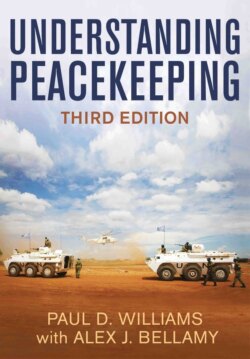Читать книгу Understanding Peacekeeping - Alex J. Bellamy - Страница 37
The bureaucratic framework for UN peace operations
ОглавлениеBefore the creation of the Department of Peacekeeping Operations (DPKO) in February 1992, UN peace operations were assembled and managed on what was effectively an ad hoc basis. We noted above how UNSCOB was established by the General Assembly; so was UNEF I in the Sinai (1956–67). In the latter case, the then Secretary-General, Dag Hammarskjöld, assumed responsibility for organizing the operation, raising the force itself by lobbying potential troop contributors, borrowing the commanding officer from UNTSO, creating its mandate and developing the rules of engagement (Baehr and Gordenker 1994: 78). And so it continued during the Cold War, with every UN peacekeeping operation set up, structured and deployed from scratch.
In 1961, Hammarskjöld created the Office for Special Political Affairs, run by two Under-Secretaries-General. This gave the UN a limited planning and implementation infrastructure for peacekeeping that proved adequate for dealing with the small numbers of operations undertaken during the Cold War. However, the twenty or so full-time staff in the Office for Special Political Affairs were clearly unable to plan and run large numbers of complex operations. In addition, the separation of peacekeeping and related functions across several departments and bureaus (such as the Field Operations Division and the Department of Administration and Management) meant that more than twenty Under-Secretaries-General reported directly to the Secretary-General, often without coordinating their activities with each other (Durch 1994b: 62).
In 1992 the UN Secretariat was restructured and the DPKO was created to alleviate some of these problems. The UN began to develop a greater institutional capacity for peacekeeping by gradually providing the DPKO with sections to deal with planning and support, logistics and procurement and lessons learning, as well as a permanently staffed situation room. Gradually, the Secretariat focused on peace operations became more professionalized and was expanded to include divisions dealing with police and rule of law and security institutions (Benner et al. 2011; Weinlich 2014; Karlsrud 2015b). While there were just fifty staffers in early 1993, by 1997 their number had grown to 450. By 2001, the number was just under 600, and by 2017 DPKO and its partner institution the (now defunct) Department of Field Support had about 920 staff between them (Novosseloff 2018: ch. 2). Despite this expansion, the pressure on the UN’s bureaucrats was huge. By mid-2007, for example, the ratio of DPKO staff to field personnel was an unbearable 1:149 (Barcena 2007: 4). A further restructuring in 2019 led to the DPKO being replaced by the UN’s new Department of Peace Operations (DPO), which has three main offices: the Office of Rule of Law and Security Institutions (OROLSI); the Office of Military Affairs (OMA); and the Policy, Evaluation and Training Division (DPET).
It is this bureaucracy that shepherds the process of assembling UN peacekeeping operations and works with the member states to generate the required capabilities for the mission. Box 2.2 describes how UN peace operations are assembled in theory. In practice, however, the process rarely works smoothly, as discussed in chapter 12. During the twenty-first century, the majority of the UN’s peacekeeping troops and police came from states in South Asia and Africa, with Bangladesh, India, Pakistan, Nepal, Ethiopia, Nigeria and Rwanda being particular stalwarts.
